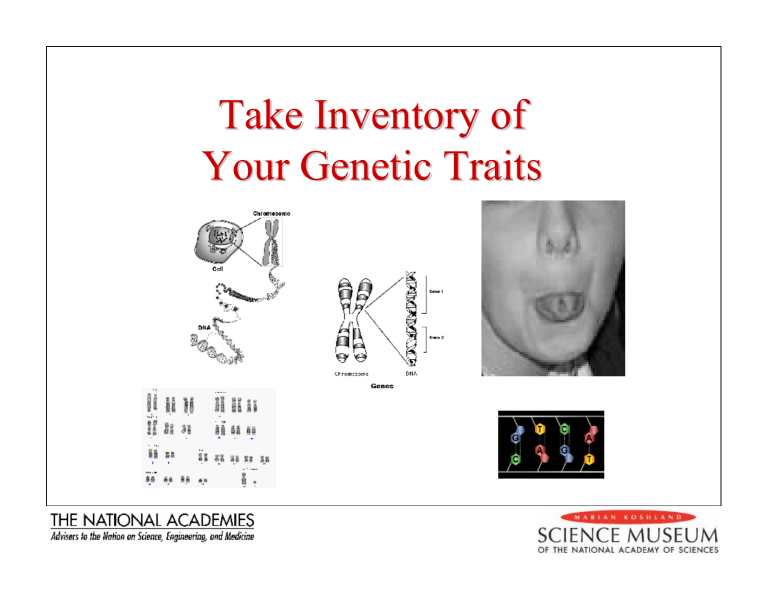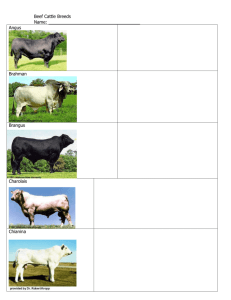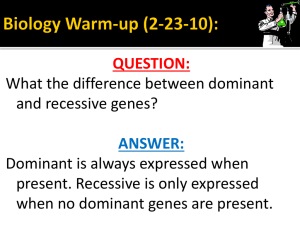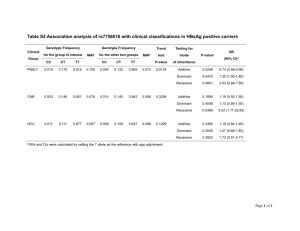
Take Inventory of Your Genetic Traits •Humans have 46 chromosomes in the nucleus of every cell, 23 from each parent. •Each chromosome consists of very tightly packed double helix DNA. •Genes are stretches of DNA found on chromosomes. •Each gene codes for a different physical trait. •The genes you inherit from your parents determine your physical traits. •Genes and traits are considered dominant or recessive, although in some cases it is not always clear. •Dominant traits occur when only one copy of the dominant gene is inherited. •Recessive traits are usually rare because you need to inherit a recessive gene from both parents. Male or Female? Male (XY) Female (XX) • Your sex is determined by whether you get an X or Y chromosome from your father. Everyone receives an X from their mother. Earlobes • Detached earlobes are believed to be dominant, but more than one gene may be involved. • Attached earlobes are considered recessive. http://www.ncbi.nlm.nih.gov/entrez/query.fcgi?db=OMIM Tongue Rolling • Rolling • Non-rolling • Rolling is thought to be dominant, but identical twin studies have cast doubt on this observation. • Non-rolling is thought to be recessive. http://www.ncbi.nlm.nih.gov/entrez/query.fcgi?db=OMIM Ear Wiggling Ear wiggling may be connected to tongue rolling in males. • Can move ears = • Can’t move ears = Dominant (although Recessive this may be variable) http://www.ncbi.nlm.nih.gov/entrez/query.fcgi?db=OMIM Dimples • Dimples are thought to be dominant. • No dimples is recessive. http://www.ncbi.nlm.nih.gov/entrez/query.fcgi?db=OMIM Hand Clasping Hand clasping is believed to be determined by genetic factors, although it is unclear if one trait is dominant over the other. • Left Thumb on Top • Right Thumb on Top • 55% of people place their left thumb on top • 44% place their right thumb on top. http://www.ncbi.nlm.nih.gov/entrez/query.fcgi?db=OMIM Cleft Chin • Cleft chins are dominant, although variable penetrance may influence expression. • No cleft is recessive. Department of Genetics, Stanford University http://www.ncbi.nlm.nih.gov/entrez/query.fcgi?db=OMIM Widow’s Peak • A widow’s peak • No widow’s peak is hairline is considered considered recessive. dominant. http://www.ncbi.nlm.nih.gov/entrez/query.fcgi?db=OMIM Hair on Middle Segment of Finger • Hair • No Hair • The presence of • No hair is recessive. hair on the middle segment of any finger is dominant. http://www.ncbi.nlm.nih.gov/entrez/query.fcgi?db=OMIM Phenylthiocarbamide (PTC) Tasting PTC is a bitter flavor compound that often causes people to dislike certain foods, such as broccoli, coffee, or beer. • PTC tasting is dominant. • Non-tasting is recessive. • 75% of individuals can taste the bitter flavor of PTC. • 25% of individuals find the paper tasteless. Image Sources: Chromosomes and Genes: The National Human Genome Research Institute, www.genome.gov Genes and Inherited Traits: Pearson Education, www.pearsoned.com Dominant/Recessive Traits: Cooperative Research Centre, www.genecrc.org Male or Female: The National Human Genome Research Institute, www.genome.gov Earlobes: Windows to the Universe, www.windows.ucar.edu Tongue Rolling, Hand Clasping: Genetic Science Learning Center at the Univ. of Utah, gslc.genetics.utah.edu Ear Wiggling, Dimples, Cleft Chin, Widow’s Peak, & PTC Tasting: Microsoft Word Clip Art, office.microsoft.com/clipart/ Hair on Middle Segment of Finger: Koshland Science Museum, www.koshlandscience.org



